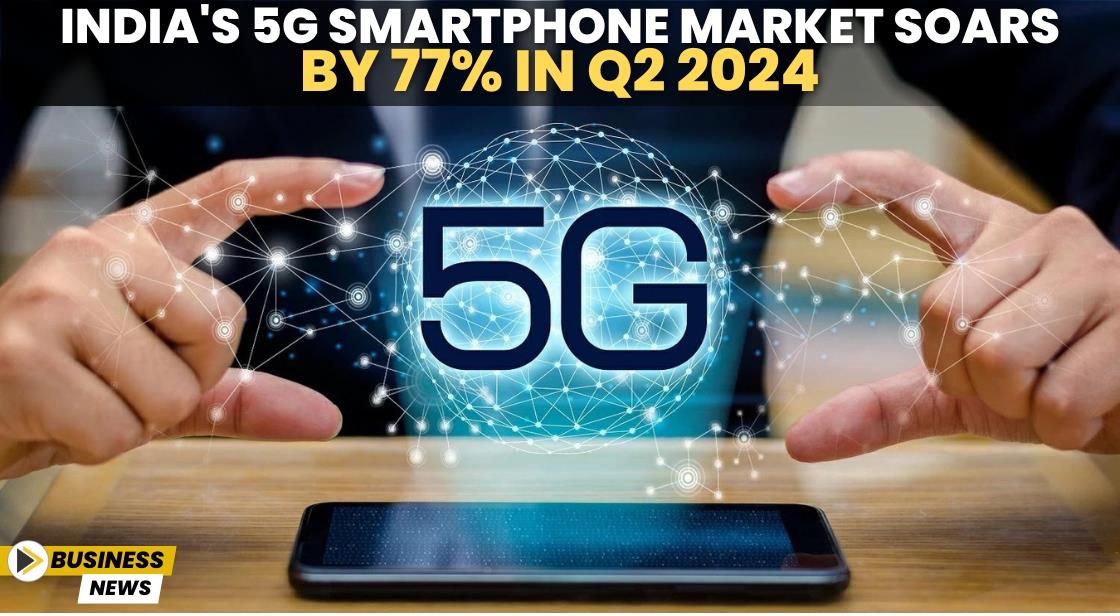India's 5G Smartphone Market Soars by 77% in Q2 2024

News Synopsis
As India continues its digital transformation, the 5G smartphone market has shown remarkable growth. According to a recent report, India’s 5G smartphone market share surged to 77% in the second quarter (Q2) of 2024, up from 49% in the same quarter last year. This impressive rise highlights the accelerating adoption of 5G technology across the country, reflecting a significant shift in consumer preferences and technological advancements.
Decline in Average Selling Price
Despite the remarkable increase in market share, the Average selling price (ASP) of 5G smartphones has experienced a notable decline. The ASP dropped by 22% to $293 (approximately Rs 24,000), which indicates a shift towards more affordable 5G devices in the market. This decrease in price is attributed to the influx of new models and increased competition among manufacturers, making 5G technology more accessible to a broader consumer base.
Shipments and Market Growth
In the April-June quarter, nearly 27 million 5G smartphones were shipped, reflecting strong consumer demand for next-generation technology. The overall Indian smartphone market saw shipments of 69 million smartphones in the first half of 2024, marking a 7.2% growth year-over-year (YoY). In Q2 alone, 35 million smartphones were shipped, with a 3.2% YoY increase. This growth signifies a positive trend in the smartphone industry, though challenges remain.
Challenges and Market Trends
Despite the growth, the smartphone market is facing challenges such as muted consumer demand and rising ASPs, which are hindering a swift annual recovery. The report notes that this is the fourth consecutive quarter of YoY shipment growth, but the market’s recovery is tempered by these ongoing issues. To address these challenges, vendors have been clearing old inventory and launching new models, particularly in the mid-premium and premium segments, in anticipation of increased sales during the monsoon season in July and August.
Segment Performance and Brand Leadership
The report highlights several key trends within different smartphone segments. The entry-level segment (sub-$100) saw a significant decline of 36% YoY, with its market share dropping to 14% from 22% a year ago. Xiaomi remained the leader in this segment, followed by Poco and Realme, indicating their continued dominance despite the segment's overall decline.
In contrast, the mass budget segment (above $100 and below $200) experienced an 8% YoY growth. This segment saw Xiaomi, Realme, and Vivo emerge as the top three brands, collectively capturing 60% of the market share. This growth reflects a strong consumer preference for budget-friendly yet feature-rich smartphones.
Premium Segment Overview
The premium segment of the smartphone market, holding a 2% share, saw a significant decline of 37% in unit terms. Key models in this segment included the iPhone 13, Galaxy S23FE, iPhone 12, and OnePlus 12. Despite the decline, Apple’s share in the premium segment increased to 61% YoY, while Samsung’s share rose to 24% from 21% a year ago. This shift underscores Apple’s continued strength in the high-end market while Samsung maintains a significant presence.
Online Channels and Sales Channels
The report also notes a shift towards online sales channels, with shipments to these platforms growing by 8% YoY. Online channels now account for 50% of the smartphone market share in Q2, up from 47% in the same quarter of the previous year. This increase reflects a growing preference for online shopping and the convenience it offers, contributing to the overall market growth.
Conclusion
India’s smartphone market is evolving rapidly, with 5G technology playing a pivotal role in this transformation. The substantial growth in 5G market share, combined with changes in pricing and segment performance, illustrates the dynamic nature of the industry. While challenges remain, the continued expansion and adaptation of new technologies signal a promising future for India’s smartphone market. As consumer preferences shift and technological advancements continue, the landscape will likely experience further evolution, driving growth and innovation in the sector.
You May Like









